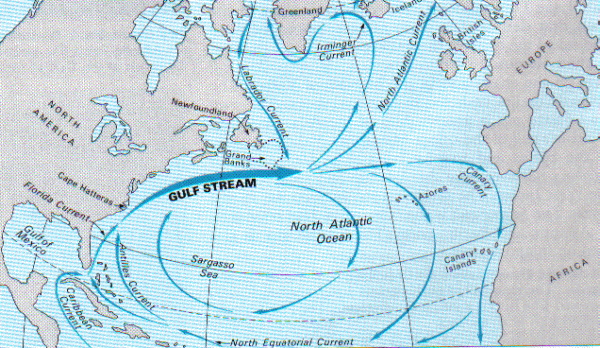E. F. Hagemeister
Gulf Stream *
The Gulf Stream was first identified in 1513 by Juan Ponce de León. It is a critical feature of the North Atlantic that is responsible for keeping the climate North-West Europe warmer than its counterpart at the same latitude of North America. However, it is wrong to assume that this benign feature has functioned permanently.
 In 1955 Professor E.F. Hagemeister of Tallin, in Estonia, published her view that based on the disintegration of ionium, an isotope of thorium, at various depths in the Atlantic, she believed that the Gulf Stream came into existence (again) around 10,000 BC. She believed that this event, the sinking of Atlantis and the ending of the last Ice Age were interrelated and that all took place around the same time.(d)
In 1955 Professor E.F. Hagemeister of Tallin, in Estonia, published her view that based on the disintegration of ionium, an isotope of thorium, at various depths in the Atlantic, she believed that the Gulf Stream came into existence (again) around 10,000 BC. She believed that this event, the sinking of Atlantis and the ending of the last Ice Age were interrelated and that all took place around the same time.(d)
It is generally accepted that during the last Ice Age the glaciation reached as far south as London. Otto Muck contended[098] that this would not have happened if the Gulf Stream had been functioning as it is today. His argument is that something had blocked its path and that the ’something’ was Atlantis. An early proponent of this idea was Edward Hull. Andrew Tomas advanced a similar notion a few years before Muck[348]. Wolter Smit, who is a keen student of Muck’s ideas, supports his views on the Gulf Stream(b). This idea was also adopted by Prescott Rawlings in his recent book, Atlantis, the Great Flood and the Asteroid[763]. Nevertheless, a 2016 report(c) from CAGE (Center for Arctic Gas Hydrate, Climate and Environment) offers evidence that the Gulf Stream was not cut off during the Ice Age.
Another view was expressed in a New Scientist article in 2007, which proposed that the bursting of a glacial lake in Canada, 8,000 years ago, dumped an estimated 100,000 cubic kilometres of water into the North Atlantic, shutting down the Gulf Stream.(e)
Gradually, evidence has been emerging that the progressive melting of the Greenland ice sheet may cause the Gulf Stream to shut down again. In 2005 data has been gathered which shows that the efficiency of the Gulf Stream has been reduced by 30% in the past 50 years and generated speculation that the Gulf Stream could shut off within ‘decades’. Such a disastrous event would, of course, seriously undermine Muck’s hypothesis, as it would demonstrate that a mid-Atlantic Atlantis was not required to generate an Ice Age. Furthermore, the Gulf Stream’s ability to absorb CO2 has also been halved(a) between 1996 and 2005.
In May 2010 the Gulf Stream briefly shutdown once again without the need for an Atlantis to cause it. At last, there appears to be a greater appreciation of the number of elements that can interfere with the flow of the Gulf Stream, such as global warming, reduced salinity(f) and geological heat flow(g).
(b) https://en.was-this-atlantis.info/gulf-stream.html
(c) https://www.sciencedaily.com/releases/2016/02/160219134816.htm
(d) https://web.archive.org/web/20091020233311/http://geocities.com/MotorCity/Factory/2583/morley.htm
(e) https://www.newscientist.com/article/dn13013-ancient-flood-brought-gulf-stream-to-a-halt/
(g) http://www.plateclimatology.com/gulf-stream-shut-down-caused-by-geological-heat-flow
